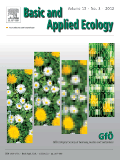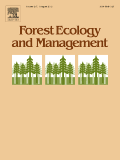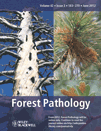
TREES-STRUCTURE AND FUNCTION
Scope & Guideline
Transforming understanding of tree physiology and ecology.
Introduction
Aims and Scopes
- Tree Physiology and Biochemistry:
Research exploring the physiological processes in trees, including photosynthesis, transpiration, and nutrient uptake, often under varying environmental conditions. - Wood Anatomy and Structural Function:
Studies focusing on the anatomical characteristics of wood, including vessel structure, density, and their implications for tree function and resilience against stressors. - Ecophysiology and Climate Interactions:
Investigations into how trees respond to climatic factors such as drought, temperature, and soil moisture, emphasizing physiological adaptations and growth patterns. - Genetic Diversity and Conservation:
Research on genetic variability among tree populations, including implications for conservation, breeding programs, and ecosystem resilience. - Urban Forestry and Ecosystem Services:
Studies addressing the role of trees in urban environments, focusing on their contributions to ecosystem services, including air quality improvement, shade provision, and biodiversity support. - Restoration Ecology and Management Practices:
Research aimed at understanding and improving restoration practices for degraded forests, including the role of tree species selection and management strategies.
Trending and Emerging
- Drought Resilience Mechanisms:
Recent publications increasingly focus on understanding the physiological and anatomical adaptations of trees to drought conditions, highlighting the importance of resilience in the face of climate change. - Urban Tree Functionality and Ecosystem Services:
There is a growing trend towards research on the roles of urban trees in enhancing ecosystem services, addressing urban heat islands, and improving air quality, reflecting the increasing importance of urban forestry. - Advanced Biotechnological Approaches:
Emerging studies utilize advanced biotechnological techniques, such as transcriptomics and metabolomics, to explore tree responses to environmental stressors and improve tree breeding and conservation efforts. - Climate Change Impact Assessments:
A marked increase in research assessing the impacts of climate change on tree growth, distribution, and health indicates a trend towards understanding long-term ecological consequences. - Microbial Interactions and Soil Health:
There is an emerging focus on the interactions between trees and soil microbiomes, particularly how these relationships affect tree health and ecosystem functioning.
Declining or Waning
- Traditional Silviculture Practices:
There is a noticeable decrease in studies focusing solely on traditional silvicultural practices, as the journal shifts towards integrating ecological and physiological research with management strategies. - Invasive Species Impact Studies:
Research specifically addressing the impacts of invasive species on forest dynamics has become less frequent, indicating a potential waning interest in this area in favor of broader ecological interactions. - Conventional Tree Growth Models:
The reliance on conventional tree growth models is diminishing as the field moves towards more integrative and complex modeling approaches that incorporate physiological and environmental variables.
Similar Journals

BASIC AND APPLIED ECOLOGY
Bridging theory and practice in the realm of ecology.BASIC AND APPLIED ECOLOGY, published by Elsevier GmbH in Germany, stands out as a premier journal in the field of ecology, evolution, behavior, and systematics. With its ISSN 1439-1791 and E-ISSN 1618-0089, the journal enjoys a distinguished reputation, evidenced by its classification in the Q1 category for Ecology in 2023 and impressively ranking #89 out of 721 in this domain according to Scopus. Since its inception in 2000, it has served as a vital platform for disseminating high-quality research that bridges theoretical insights and practical applications in ecology. Researchers, professionals, and students alike can look forward to the latest findings that not only foster a deeper understanding of ecological processes but also inform sustainable practices crucial for our environment. As the journal continues its journey through to 2024, it remains committed to advancing ecological knowledge and supporting innovative research in an ever-evolving field.

Tree Genetics & Genomes
Unlocking the genomic secrets of trees for a greener tomorrow.Tree Genetics & Genomes is a premier academic journal published by Springer Heidelberg, dedicated to advancing the field of tree genetics and genomics. Since its inception in 2005, this journal has played a crucial role in disseminating high-quality research that addresses critical questions in tree biology, horticulture, and forestry. The journal is highly regarded within the academic community, as evidenced by its impressive Q1 rankings in both Forestry and Horticulture categories for 2023 and a substantial presence in key genetic research areas. Furthermore, its Scopus rankings affirm its influence across disciplines, ranking among the top journals in Agricultural and Biological Sciences. Although currently not an open-access publication, it aims to provide authors and readers with a platform to share innovative findings and insights that shape sustainable practices in tree planting and management. With a commitment to fostering knowledge in the genetic and genomic analysis of trees, Tree Genetics & Genomes is an essential resource for researchers, professionals, and students alike, contributing to the global understanding of tree biology and its environmental significance.

FOREST ECOLOGY AND MANAGEMENT
Elevating Knowledge in Forest EcosystemsFOREST ECOLOGY AND MANAGEMENT is a premier peer-reviewed journal dedicated to the integral study of forest ecosystems and their management, published by Elsevier in the Netherlands. With an impactful presence in the field, this journal boasts a prestigious Q1 ranking in multiple categories, including Forestry, Management, Monitoring, Policy and Law, and Nature and Landscape Conservation as of 2023. It addresses key issues relevant to sustainable forest practices, conservation strategies, and environmental monitoring, making it a vital resource for researchers, practitioners, and policymakers alike. The journal is indexed with an impressive Scopus rank, placing it among the top tier of titles in Agricultural and Biological Sciences and Environmental Science. While it does not offer Open Access options, its rigorous review process and high visibility make it essential for those seeking to stay abreast of the latest findings and trends in forest ecology and management. Published continuously since 1976, FOREST ECOLOGY AND MANAGEMENT aims to foster interdisciplinary collaboration and advance knowledge critical to the stewardship of forest resources in an ever-changing global landscape.

Dendrobiology
Innovating methodologies for sustainable forestry practices.Dendrobiology is a distinguished academic journal published by BOGUCKI WYDAWNICTWO NAUKOWE, focusing on the intricate and essential disciplines of forestry and plant science. Since its inception in 2000, the journal has served as a critical platform for the dissemination of high-quality research, advancing our understanding of dendrology and its vital role in ecosystem management and biodiversity conservation. With impressive rankings in Scopus—placing it in the second quartile for Forestry and third quartile for Plant Science—Dendrobiology is recognized for its impactful contributions to the field, with a focus on innovative methodologies and sustainable practices. Although it currently operates under a conventional publishing model, the journal emphasizes accessibility and engagement, catering to a broad academic audience, including researchers, practitioners, and students who are keen to explore pioneering research and developments. By fostering a collaborative academic dialogue, Dendrobiology aims to bridge theoretical foundations with practical applications, ensuring relevance in today’s rapidly evolving fields.

NEW PHYTOLOGIST
Illuminating the Path of Plant ResearchNEW PHYTOLOGIST is a premier international journal published by WILEY, focusing on the field of plant science and physiology. Operating since 1902, this esteemed journal has established itself as a vital resource for researchers and professionals alike, offering cutting-edge research and insights into the complex workings of plants and their physiological processes. With an impressive impact factor and recognized in the top quartile (Q1) of both the physiology and plant science categories, it ranks #8 and #9 respectively in their fields, placing it within the top 2% of journals. NEW PHYTOLOGIST is not only essential for enhancing the understanding of plant biology but also for addressing global challenges such as food security and environmental sustainability. Although it does not currently offer open access, the journal remains committed to disseminating knowledge to a wide audience through institutional subscriptions and partnerships. This journal continues to drive advancements in plant science into the future, making it an invaluable asset for students, researchers, and industry professionals.

FOREST PATHOLOGY
Unraveling the Secrets of Forest EcosystemsFOREST PATHOLOGY is a premier journal published by Wiley that focuses on the intricate relationships between trees, pathogens, and forest health. With an ISSN of 1437-4781 and an E-ISSN of 1439-0329, this British journal has garnered an impressive reputation in the fields of Ecology and Forestry, achieving a Q2 Quartile ranking in both categories as of 2023. The journal invites researchers and professionals to explore cutting-edge studies and case reports that delve into forest pathology, contributing to the understanding of disease dynamics and management in forest ecosystems. Currently indexed in Scopus, it ranks 61st out of 174 in the Forestry category and 214th out of 461 in Ecology, reflecting its impact and relevance in advancing the field. Access options are available to cater to a wide audience, emphasizing the journal's commitment to disseminating vital knowledge that enhances forest management practices and ecological resilience. FOREST PATHOLOGY stands as an essential resource for those dedicated to the health and sustainability of forest ecosystems.

TREE PHYSIOLOGY
Pioneering Insights into Plant FunctionalityTREE PHYSIOLOGY, published by Oxford University Press, is a leading journal dedicated to the field of plant science and physiology, with a significant impact factor that highlights its importance in the academic community. Established in 1990, this journal has evolved to encompass a wide range of topics relating to the physiological processes of trees and woody plants, offering valuable insights to researchers and professionals alike. With its Q1 ranking in Plant Science and Q2 in Physiology for 2023, TREE PHYSIOLOGY is recognized for its high-quality, impactful research articles. Its Scopus rankings further emphasize its relevance, placing it in the top percentile within its categories, making it an essential resource for those involved in agricultural and biological sciences. Although it does not currently offer Open Access options, the journal remains committed to promoting the advancement of knowledge through rigorous peer review and scholarly excellence. Located in the United Kingdom, it serves an international audience, fostering collaboration and innovation in the study of tree physiology.

Ecosistemas
Exploring the intricate web of ecosystems and sustainability.Ecosistemas is a prominent Open Access journal published by the ASOCIACION ESPANOLA ECOLOGIA TERRESTRE, specializing in the field of ecology. Since its inception in 2001, it has dedicated itself to advancing ecological knowledge and research, fostering an inclusive platform for the dissemination of cutting-edge studies that span ecological interactions, sustainability, and biodiversity. The journal, based in Spain, has established its reputation with notable rankings such as Q3 in the field of Ecology and Q4 in Ecology, Evolution, Behavior, and Systematics, reflecting its commitment to quality research. With a Scopus Ranks position placing it in the 40th and 37th percentiles for its categories, Ecosistemas is integral to the academic community, serving researchers, professionals, and students alike. It provides a vital resource for those seeking to understand ecological dynamics and environmental challenges, facilitating open access to important findings and discussions that shape the future of our ecosystems.

BOSQUE
Pioneering Research in Forestry and BeyondBOSQUE, published by Universidad Austral de Chile, Facultad de Ciencias Forestales, stands as a pivotal platform for advancing the field of forestry and related environmental sciences. With an ISSN of 0717-9200, this journal has been committed to disseminating original research, reviews, and case studies essential for understanding forest ecosystems and management practices since its inception in 2006. As of 2023, it holds a Q3 ranking in the forestry category, showcasing a significant yet developing influence in the broader academic landscape, evidenced by its Scopus ranking placing it at the 12th percentile in Agricultural and Biological Sciences - Forestry. While boasting a diverse range of articles, BOSQUE promotes open access to a growing community of researchers, professionals, and students eager to contribute to sustainable forest management and conservation efforts. The journal continues to foster critical dialogue and innovation, making it an invaluable resource for those dedicated to enhancing forest sciences.

Icelandic Agricultural Sciences
Advancing Agronomy Through Innovative ResearchIcelandic Agricultural Sciences, published by RANNSOKNASTOFNUN LANDBUNADARINS, serves as a vital platform for the dissemination of research in the field of Agronomy and Crop Science. Established to contribute to the advancement of agricultural knowledge in Iceland and beyond, this journal aims to foster collaboration among researchers, professionals, and students dedicated to sustainable agricultural practices. Despite facing a Q4 category ranking in 2023 and a ranking of #344/406 in Scopus, the journal continues to attract diverse research contributions, especially focusing on unique challenges and innovations pertinent to Icelandic agriculture. The journal operates under a traditional access model, providing an essential resource for those looking to deepen their understanding of agronomic developments and their implications for the agricultural sector. With a commitment to increasing awareness and promoting scientific dialogues, Icelandic Agricultural Sciences plays a crucial role in nurturing the field's growth and enhancing agricultural research.